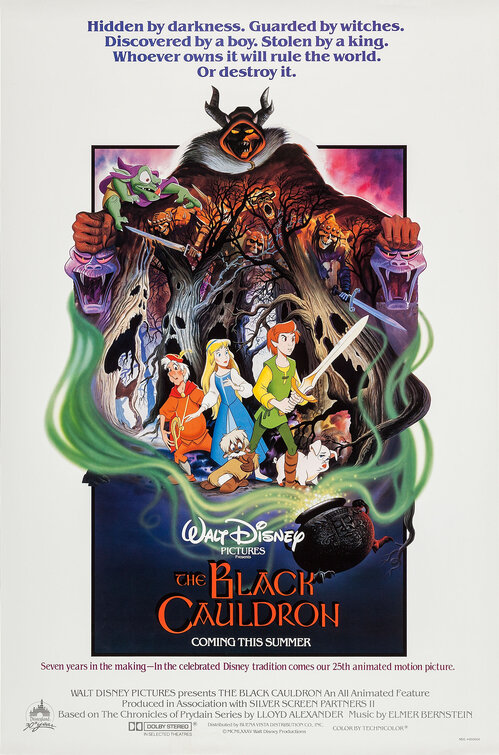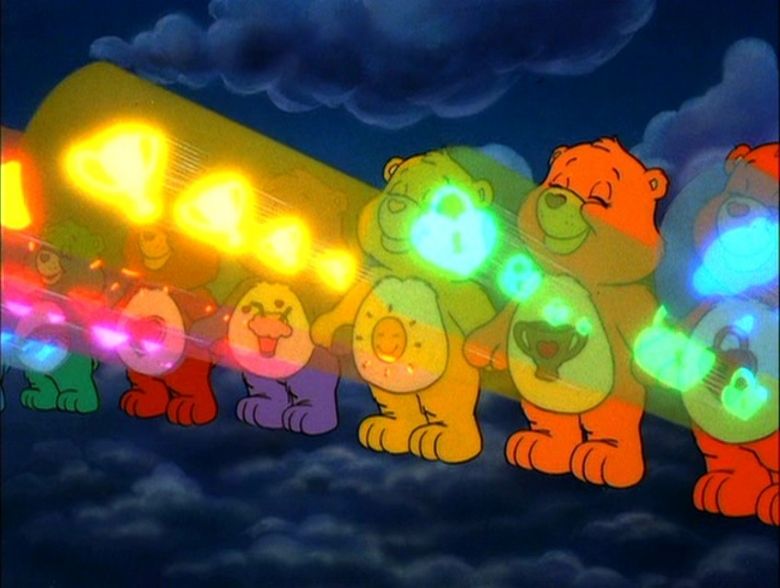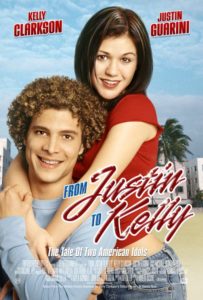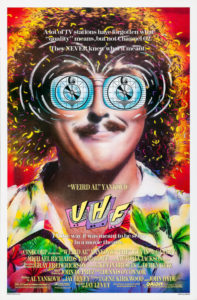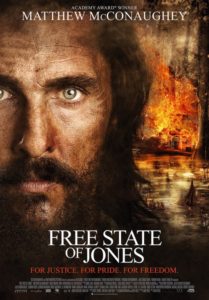Spoiler Warning: This review goes into plot details and specifics of the film. If you haven’t seen this film and want to, proceed with caution.
Background
By the middle of the 1980s, Walt Disney Studios, responsible for numerous classics since Snow White, was in a crisis. Walt himself had been dead for some time, leaving the company, particularly the animation department, without a leader. The animation department was split into multiple divisions and scattered throughout warehouses in Burbank, and without Walt’s guidance rarely spoke to each other. This may partially have been about conflicting personalities, but it was mostly related to artistic freedom. Animated films had a more relaxed production schedule than they have now, and each division worked on a different aspect of the film. The mindset was that of artists believing their best work came forth without outside meddling. That’s all well and good when someone’s working on his or her own project, but if it’s a project involving a bunch of different people and ideas, you can end up with a puzzle with a lot of pieces that don’t fit together. This is especially true for the inherently collaborative medium of film. Add the exceptionally more difficult and involved field of animation, you start to see a problem. If the pieces aren’t compatible, things have to be redone, leading to considerable time and money being spent to fix it. Costs can be mitigated a bit with CGI, but that technology was far more limited back then.
This work style had caught up to the Disney Animators. By 1985, they had only completed and released three films in the last decade, and one of those was a compilation film. Not helping matters was the fact that they weren’t seeing as much money come in as before. Disney films were seen as kiddie fare, so teens and adults were staying away. To appeal to a new demographic, the decision was made to make something more adult, and the source material was to be Lloyd Alexander’s popular fantasy series “The Chronicles of Prydain.” That posed another problem: this was a 5 book series, and Disney had a strict “no sequels” rule at the time. So, this would have to be a very loose adaptation, combining multiple elements from different books to make a self-contained movie. They eventually settled on adapting the second book, The Black Cauldron, with plot elements and characters of the first book combined with it. Surely, with these details ironed out, it would be smooth sailing from here, right? Well, no. The aforementioned lack of communication reared its ugly head, and once production actually started, it still took seven years to get the film to the screen. Promising animators, such as Don Bluth and Tim Burton, were lured to the company to work on the film, but left when they grew tired of the poor organization. The budget eventually ballooned to at least $25 million, though later estimates have gone as high as $44 million, a huge budget in the 80s.
Enter the new Chairmen, Michael Eisner and Jeffrey Katzenberg. They were appointed in 1984 specifically to get the company back on track. One of the first things they took a look at was the animation department. Neither of them knew much about animation, but even they could see how poor the current layout was. When they were shown a completed version of The Black Cauldron, they were horrified with the realization that the first film to be released under their leadership would be a massive bomb. Katzenberg even forced himself into the editing booth and started cutting the film himself, not understanding that there were no shots to replace the cuts. Eventually, a compromise was reached to cut 12 minutes of the film, mostly of the frightening imagery in the climactic Cauldron Born sequence. They took their chances and released the final cut in the Summer of 1985, where it proved a dud. As an example of how bad things were for Disney, The Black Cauldron couldn’t even outgross The Care Bears Movie, which was released at the same time. Eisner and Katzenberg briefly contemplated shutting down the entire animation department, but eventually decided to overhaul it, and The Black Cauldron was declared an embarrassment, just the final excuse needed to change the way things were run. For a long time, the film was mostly forgotten, and called a disaster when it wasn’t. For many who view the movie today, the question remains: is it really that bad? Did it deserve to be forgotten? To find out, let’s take a look at today’s Summer Blockbuster That Wasn’t, The Black Cauldron.
The Film
As stated before, this film is loosely based on “The Chronicles of Prydain” series by Lloyd Alexander. I have never read any of those books, so I can’t accurately compare the quality of the movie to the books. However, I have looked up descriptions of the books for this, and they sound pretty good. They sound kind of like a lighter Lord of the Rings-style fantasy. The story of the film is the fairly standard Hero’s Journey that had become common since Star Wars. A young boy named Taran dreams of becoming a great warrior, but is stuck working on a farm and caring for a pig named Hen Wen. One day, Taran’s master, Dallben, reveals that Hen Wen has oracular powers, and the evil Horned King wants to use her to find the mythical Black Cauldron so he can raise his undead army and take over the world. He instructs Taran to take the pig to safety. However, Taran quickly loses her thanks to his daydreaming. Taran meets a mischievous creature named Gurgi, who helps him find Hen Wen, but the pig is taken to the Horned King’s castle by his dragons. Taran manages to rescue Hen Wen, but is captured himself. While imprisoned, he meets Princess Eilwonwy and the bard Fflewddur Fflam. The three of them escape with the help of Gurgi, and team up to find Hen Wen. They find her in the care of fairy-like beings called the Fair Folk, who reveal where the Cauldron is. Now teamed with Doli, one of the Fair Folk, they head off to find the Black Cauldron and destroy it.
It’s a basic setup and story for an adventure, but it’s used so often because it works when executed properly. A hero’s journey was the natural direction to take this story. It could appeal to an older audience while being easy to follow for younger kids. In execution, however, they failed to strike a balance, leading to the common problem of an uncertain audience. Producer Joe Hale and directors Ted Berman and Richard Rich were clearly desperate to attract an older audience, so they included mature imagery such as the cool, scary design of the Horned King (voiced by the late, great John Hurt), an axe threatening Hen Wen’s head, 3 busty witches, an undead army, and some violent and graphic deaths. But the story and characters are so simple and thinly sketched that the whole thing feels more like an outline than a finished film. Enough of the common Disney tropes are employed with little variation that the older audience was still alienated, while the younger audience who usually enjoyed Disney’s output was left terrified. Reportedly, parents had to leave the theater during test screenings when their children started crying. Finding a balance for older and younger audiences is something Disney Animation improved upon later, but the result here is a lot of mood whiplash.

This was the first animated Disney film to use CGI. It can be seen in scenes with bubbles, a boat, an orb of light, and the cauldron. In addition, several other techniques were used. It looks good, and at times truly beautiful, though the scenes that were edited clearly jump in places. However, thanks to the aforementioned lack of communication, the overall style appears disjointed, as if some parts were meant for different films. The different styles do not mesh well together. The fair folk sequence is the most obvious offender. The leads and the fairies look like they come from wildly different worlds, and even the fairies themselves are inconsistent.
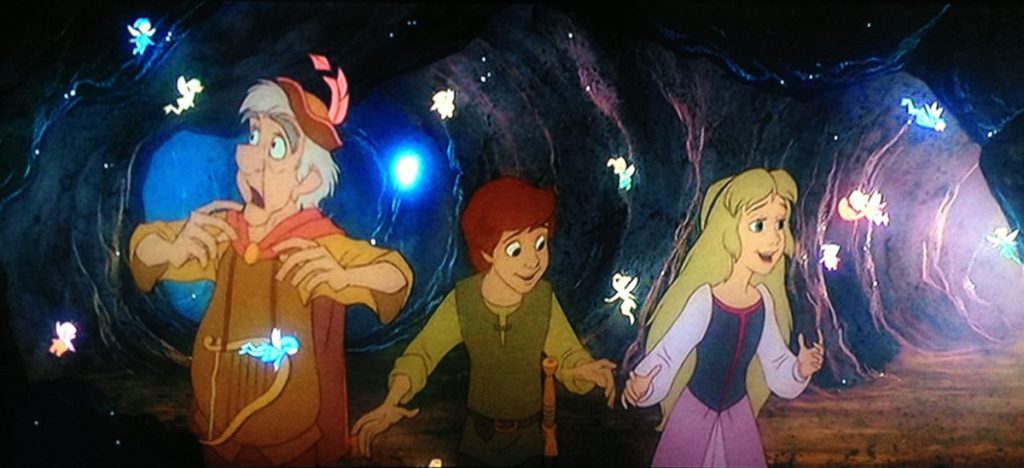
As a result of the compressed adaptation, or maybe of the film’s troubled production, neither the characters or world are properly fleshed out. We get a quick introduction of the history of the titular cauldron in the opening narration, as if that’s the question that requires an answer. When we meet Taran, he immediately shows his desire to be a hero, but why? The history of Prydain is never explained or shown, nor are the knights and heroes Taran idolizes. Does he want to fight against the Horned King? He is spoken of early on, but he’s not treated like an immediate threat, and no one else seems to be fighting him. Hen Wen seems like a normal pig, but Dallben just drops that she has magic powers with no explanation. There doesn’t need to be a long explanation, but there should be some details about how this world works. Why does this pig have these powers? Do other pigs have them? Did someone give them to this pig? Is it just random? How did the Horned King learn of this pig’s powers? The poor worldbuilding is only worsened on the journey. Outside of the few people who join Taran, we never see any of the ordinary people the Horned King is supposedly oppressing, making it really difficult to worry about this world they’re trying to save. The only people Taran runs into are the Horned King’s soldiers, the Fair Folk, who come out of nowhere, and the witches, who seem completely neutral in the conflict. A magic sword is discovered at one point, but it’s history remains unknown. Maybe it’s Excalibur, and this takes place in the same universe as The Sword in the Stone.
Taran is a protagonist in the typical hero mold. He comes from an average background, doesn’t appreciate his lot in life, and wants to be a hero and live a life of excitement. Thing is though, he’s really annoying about it. From the beginning, he’s constantly bragging about how great he is, whining when others don’t recognize that, and failing to display any true ability. As soon as Taran leaves the farm, he loses Hen Wen due to his own daydreaming. He gets harder to root for when he meets his traveling companions because he treats them like crap.
He meets Gurgi while searching for Hen Wen, and Gurgi immediately decides he wants to be his friend. Some have called Gurgi annoying, but I think it has more to do with how manipulative the film is in trying to make him likeable. He’s small, furry, has needy eyes, and sounds like a proto-Gollum thanks to the voice acting of John Byner. It quickly becomes apparent that he is lonely, so he attaches himself to Taran. But our hero spends most of the movie treating him like dirt and calling him a coward. The worst case of this is when Taran sneaks into the castle to rescue Hen Wen, and he bertates Gurgi just for being a little apprehensive about going into such a dangerous place. The reason for all this is to set up for the arcs both character will go through, but their relationship is too poorly developed for the payoff to mean much.
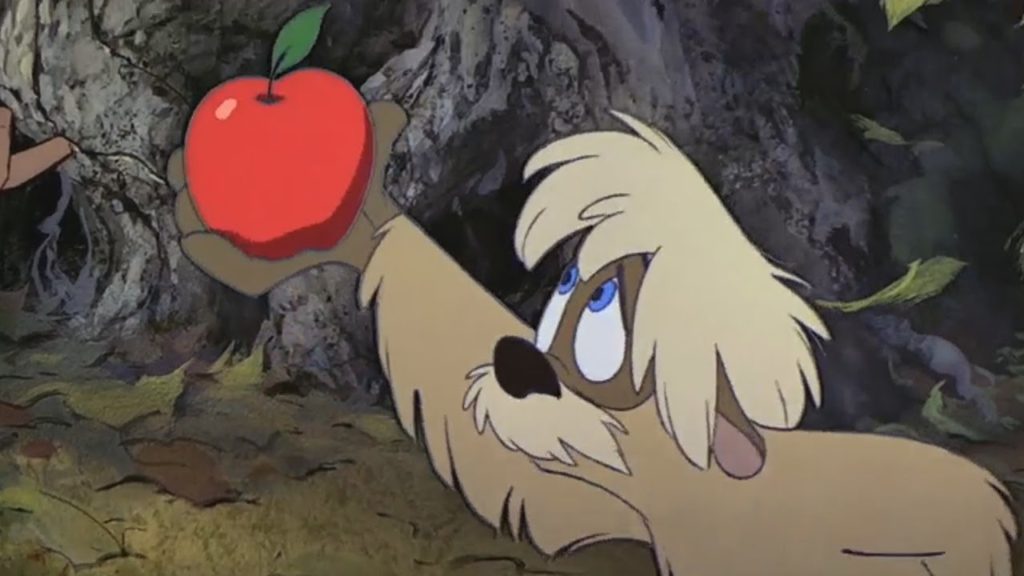
The others are a mixed bag. Princess Ellonwy serves the purpose of helping Taran escape his cell, but serves little purpose beyond that besides being the girl of the group and the love interest. Her being a Princess is never expanded upon and has no relevance. Hen Wen serves her purpose and disappears halfway through. Doli exits the movie as quickly as he enters. Fflewddur Fflam comes off the best. He’s funny, odd, and nervous, but keeps the group on track, and is smarter than he first appears. He’s the one who outsmarts the witches at the end. The lively voice work by Nigel Hawthorne helps immensely. Of all the character’s he’s the one whose history would be the most interesting to see.
For those who remember The Black Cauldron at all, the Horned King tends to be the most popular character. It’s easy to see why. He has a creepy and unique design, a horrifying goal, and isn’t afraid to use violence. His introduction is awesome. He’s cold, mean, and threatening. He abuses his lackey for any mistake, and doesn’t mess around with his prisoners. He wants the Cauldron, and he’s willing to hurt or kill Taran and Hen Wen to get it. It’s a great villain introduction. It’s also the most he does in the film. It’s never explained just how long the Horned King has ruled over Prydain or how he took over. He never leaves his castle. When he finally manages to raise his undead army, all they do is kill his own soldiers. It’s unclear why he needs the undead army, because he’s already got an army, and he’s already conquered everything we see. When the heroes foil him, it looks like he’s finally about to justify the build up, but he just trips and dies by his own device. The Horned King is ultimately a missed opportunity to make a truly fascinating villain. He’s got a cool look, but the only memorable parts of him are the superficial parts.

The second half of the film brings in three witches who possess the cauldron. This sequence has the oddest insertion of adult humor in the film. Fflewddur Fflam is turned into a frog, and ends up the cleavage of one of them who desires him. The sequence is framed in a way that holds on the joke for so long, it becomes more creepy than funny. The problem isn’t just that he’s a frog in a woman’s cleavage, it’s that he’s a man being assaulted, turned into a frog, and trapped in a woman’s cleavage, a woman he wants nothing to do with, and it goes on too long. Once that’s done, we do finally get to the next part of Taran’s arc, when they agree to trade the cauldron for his sword. He agrees, finally showing one of the basic aspects of heroism: self-sacrifice. He’s putting the needs of others ahead of his wish to be a warrior, and he finally shows what makes him a decent protagonist.
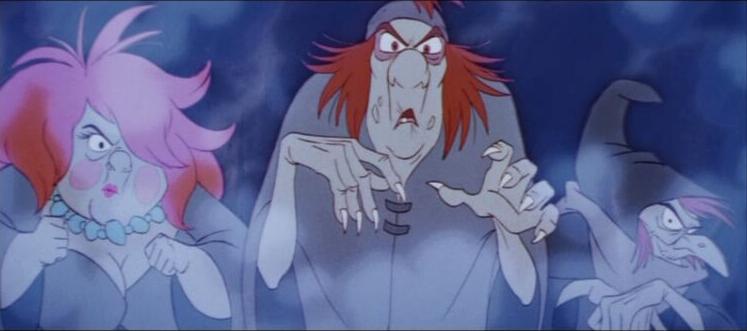
There are some decent subversions of the usual character arcs. Gurgi sacrifices himself for his only friends to stop the Cauldron Born army (a rather shocking depiction of suicide in a Disney film), and Taran sacrifices the magic sword, both to destroy the cauldron and to bring Gurgi back to life. Throughout the film, Taran had repeatedly shown that he is not fit to be a warrior, and to his credit, he seems to realize that. He learns to sacrifice his dream for the greater good, and to save his friend. It’s a nice message about what truly makes a hero. If only the group dynamic had been developed properly. The character interactions are too bland and stiff for any bond to naturally form. The final scene shows Dallben and Dali watching them in a vision, acting like this was part of some plan. It makes little sense, and probably should’ve been cut. In a way, though, it’s an appropriate ending for what The Black Cauldron is: a film that could’ve been better had more thought been put into the story itself.
GRADE: C
The ladies over at the podcast “I Hate it, but I Love it” gave this movie the apt description “the Jerry Gergich of Disney movies.” It tries hard, and wants to be liked, but this movie is disjointed, uninspired, and forgettable. It’s a fairly average Disney story, and the most adult thing about it is some of the imagery, which feels jarring and out of place. Some of the character arcs are surprising, and the animation will be fascinating to those who study the history of the art. It’s mainly interesting as a curio, and it’s not a difficult watch, but don’t expect a lost classic. In the end, The Black Cauldron was an important film in Disney history, but not for the reasons the studio hoped. It gave Eisner and Katzenberg the excuse to rebuild the animation division, to work together with more oversight to make movies faster and cheaper, leading to the Renaissance of the 90s. For better or worse, this movie changed the course of Disney history.
If you’d like to read more about the production side of this film, it’s well documented. Some good starting points would be:
http://www.slate.com/articles/arts/dvdextras/2010/10/the_black_cauldron.html
https://medium.com/@marketingwhirlwind/a-disney-disaster-the-black-cauldron-part-1-a7619a1d0898
https://www.tor.com/2015/10/08/a-demoralizing-disaster-disneys-the-black-cauldron/
http://michaelperaza.blogspot.com/2010/09/cauldron-of-chaos-part-1.html

